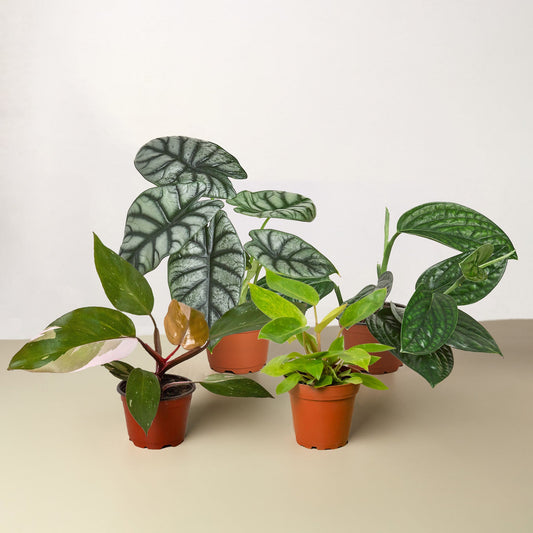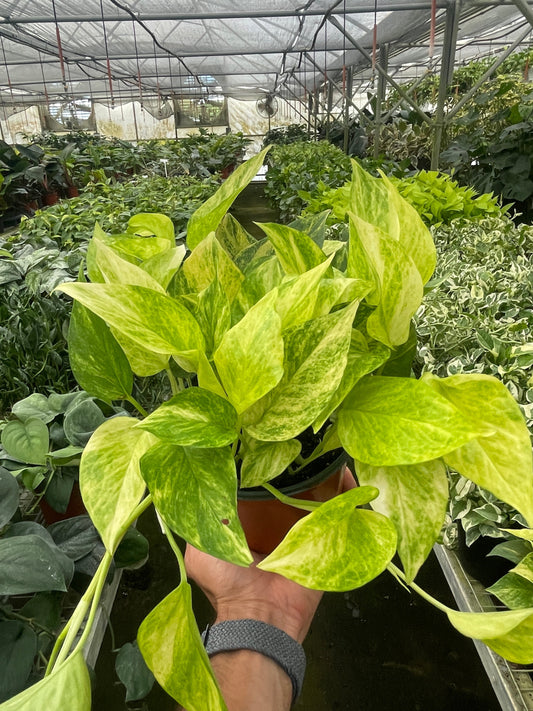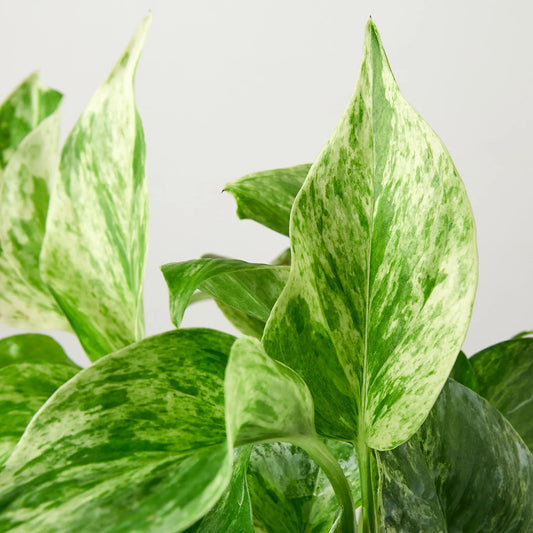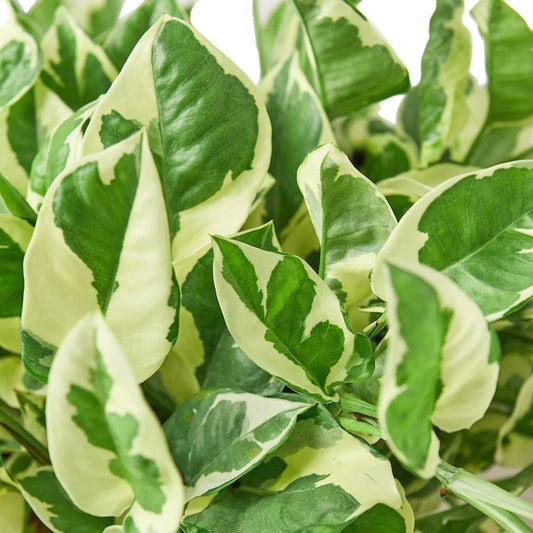Philodendron Emerald Green Aerial Roots: Everything You Need to Know
Cafe Planta Team
Philodendrons are a popular choice for plant lovers, and among them, the Philodendron Emerald Green stands out with its lush, vibrant foliage. But there's another fascinating feature that often captures the attention of plant parents: aerial roots. These roots are more than just an intriguing aspect of your plant's appearance; they play a crucial role in its overall health and growth.
In this article, we'll explore everything you need to know about Philodendron Emerald Green's aerial roots. From understanding their purpose and how they affect your plant, to practical tips on caring for them and incorporating them into your home decor, we've got you covered. Whether you're a seasoned plant parent or just getting started, this guide will provide valuable insights to help your Philodendron thrive.
What Are Aerial Roots?
Aerial roots are a unique feature of many tropical plants, including the Philodendron Emerald Green. Unlike the roots we're used to seeing that dig deep into the soil, aerial roots grow above the ground. They emerge from the plant's stem and can often be seen reaching out in the air, which is why they're called "aerial."
These roots aren't just for show. In their natural habitat, aerial roots help plants climb and secure themselves to trees or other structures. They absorb moisture and nutrients from the air, which is crucial in the often humid environments where these plants originate. Think of them as the plant's way of giving itself a little boost, both in terms of stability and nutrition.
On the practical side, aerial roots can be a bit of a mystery for indoor plant care. Should you tuck them back into the soil? Are they a sign of something wrong? While it might seem a bit perplexing at first, understanding the role of these roots will help you appreciate their presence and care for them properly.
The Purpose of Aerial Roots in Philodendron Emerald Green
Aerial roots serve several important functions for the Philodendron Emerald Green. First and foremost, they help the plant climb. In the wild, these plants often grow as epiphytes, meaning they live on other plants without harming them. The aerial roots act like little anchors, allowing the plant to secure itself as it reaches for the light.
Another essential role of aerial roots is moisture absorption. In the humid jungles where these plants are native, the roots can draw in water from the air, helping the plant stay hydrated even when soil moisture is low. This ability is particularly beneficial during periods of drought or when the plant is growing in less-than-ideal soil conditions.
Finally, aerial roots can also absorb nutrients from organic material they come into contact with, such as decaying leaves or bark. This extra nutrient boost can be crucial for the plant's health and growth, especially if the soil isn't providing everything the plant needs.
How to Care for Aerial Roots
Caring for the aerial roots of your Philodendron Emerald Green is an essential part of its overall care. While these roots are low-maintenance, there are a few things you can do to ensure they're healthy and functioning as they should.
First, keep in mind that aerial roots thrive in humidity. If your home is dry, consider misting the plant regularly or placing it in a more humid environment, like a bathroom with a window. You could also use a humidity tray by placing a bowl of water near the plant to increase the moisture in the air.
Trimming aerial roots is generally not recommended unless they're becoming problematic, such as entangling other plants or objects. If you do need to trim them, use clean, sharp scissors to make a clean cut, and avoid cutting too close to the stem.
If you're wondering whether to guide these roots back into the soil, it's usually not necessary. However, if you prefer a tidier appearance, gently tuck them into the potting medium. Just ensure that the medium is loose enough to allow air circulation, as aerial roots still need access to the air to function correctly.
Incorporating Aerial Roots into Your Home Decor
Aerial roots can add an interesting and natural element to your home decor. They give your Philodendron Emerald Green a wild, jungle-like appearance that can be quite appealing. If you're looking to incorporate them into your interior design, here are a few ideas:
- Use Moss Poles: Moss poles are a fantastic way to give your plant something to climb on. They mimic the natural environment of the Philodendron, allowing the aerial roots to attach and climb, enhancing the plant's vertical growth.
- Create a Living Wall: If you're feeling ambitious, consider using multiple Philodendrons to create a living wall. The aerial roots will add texture and depth, making it a stunning focal point in any room.
- Decorative Trellises: Trellises aren't just for outdoor plants. Use a decorative trellis indoors to guide your Philodendron's growth. The aerial roots can attach to the trellis, creating a beautiful display.
Whether you choose to highlight the aerial roots or keep them more contained, they can be a fascinating and beautiful part of your plant's appearance.
Common Concerns About Aerial Roots
It's not uncommon for new plant parents to have concerns about aerial roots. They can look a bit unruly, and it's natural to wonder if they're a sign of something wrong with your plant. Let's address a few common worries:
- Are Aerial Roots a Sign of Poor Health? Not at all. Aerial roots are a natural part of the Philodendron's growth and indicate that your plant is thriving. They're not a sign of distress, so there's no need to worry.
- Do Aerial Roots Damage Other Plants? Aerial roots are not parasitic, so they won't harm other plants. They're simply looking for something to cling to and won't take resources from other plants in your collection.
- Can I Trim Aerial Roots? While trimming isn't usually necessary, you can trim aerial roots if they're getting in the way or if you prefer a neater appearance. Just be gentle and avoid cutting too close to the main stem.
Understanding the nature of aerial roots can help put your mind at ease and allow you to appreciate them as a healthy part of your plant.
Potting and Soil Considerations for Philodendron Emerald Green
When it comes to potting your Philodendron Emerald Green, the right soil and pot are crucial. These elements can impact the health of both the plant and its aerial roots.
Philodendrons prefer well-draining soil. A mix that includes peat, perlite, and orchid bark can provide the right balance of moisture retention and drainage. This type of soil allows the roots to breathe while still providing the nutrients and moisture the plant needs.
As for the pot, choose one with good drainage. A pot with a few holes at the bottom will help prevent water from pooling, which can lead to root rot—a condition that can affect both the soil and aerial roots.
Repotting is also an opportunity to check on the health of the roots, including the aerial ones. If you notice any signs of rot or decay, trim those areas back and adjust your watering habits to prevent future issues. Generally, you should repot your Philodendron every couple of years or when you see roots growing out of the pot's drainage holes.
Dealing with Pests and Fungal Issues
Like any houseplant, Philodendron Emerald Green can occasionally face pest and fungal challenges, which can affect both soil and aerial roots. Common pests include spider mites, mealybugs, and aphids. These pests can cause damage to the plant and its roots by sucking out the plant's juices, leading to wilting or yellowing leaves.
To tackle pests, regularly inspect your plant and wipe down the leaves and aerial roots with a damp cloth. You can also use insecticidal soap or neem oil as a natural remedy. Make sure you cover all areas of the plant, including those aerial roots, as pests can hide there.
Fungal issues can also arise, especially in overly damp conditions. Ensuring good air circulation and avoiding overwatering are your best defenses. If you notice any fungal growth, such as mold or mildew, remove the affected areas and treat the plant with a fungicide.
Caring for your Philodendron's health holistically will support both the soil roots and aerial roots, ensuring a thriving plant overall.
The Role of Light and Temperature
Light and temperature play significant roles in the health of your Philodendron Emerald Green, impacting both its growth and the development of aerial roots. Let's break it down:
Light: Philodendrons generally prefer bright, indirect light. Direct sunlight can scorch the leaves, while too little light can slow growth and lead to leggy stems. A spot near a window with filtered light is often ideal. If you notice the aerial roots reaching aggressively towards a light source, it might be a sign your plant needs more light.
Temperature: These plants thrive in temperatures ranging from 65°F to 80°F (18°C to 27°C). They don't like the cold, so keep them away from drafts or chilly windows during the winter months. If your plant is too cold, you might notice a lack of growth or drooping leaves, which can also affect the aerial roots.
By providing the right light and temperature conditions, you'll ensure that both the plant and its aerial roots are healthy and happy.
Creating a Supportive Environment
Creating a supportive environment for your Philodendron Emerald Green involves more than just providing the right pot and soil. It also means paying attention to its surroundings and ensuring it has everything it needs to flourish.
Consider the humidity levels in your home. Philodendron Emerald Green thrives in humid conditions, so if your home is on the dry side, consider using a humidifier or regularly misting the leaves and aerial roots. You can also group plants together, as this creates a micro-climate that increases humidity naturally.
Another aspect to consider is airflow. Good air circulation helps prevent fungal issues and supports the overall health of the plant. Make sure your Philodendron isn't crowded by other plants or furniture, allowing air to move freely around it.
Lastly, keep an eye on the cleanliness of your plant. Dust can accumulate on leaves and aerial roots, hindering their ability to absorb moisture and light. A gentle wipe with a damp cloth every few weeks can keep your Philodendron looking its best.
Final Thoughts
The Philodendron Emerald Green is a stunning plant with its vibrant leaves and intriguing aerial roots. By understanding the purpose of these roots and learning how to care for them, you're well on your way to helping your plant thrive. Remember to consider factors like humidity, light, and overall plant health to ensure your Philodendron remains a beautiful part of your home.
At Cafe Planta, we believe in the power of plants to bring joy and beauty into our lives. Whether you're just starting your plant journey or you're a seasoned plant parent, we're here to help. If you have any questions, feel free to email us or reach out via Instagram. We're excited to share our love of plants with you!



















